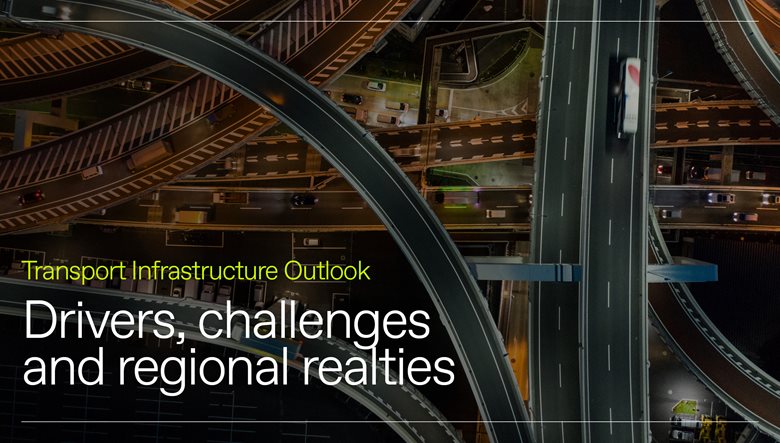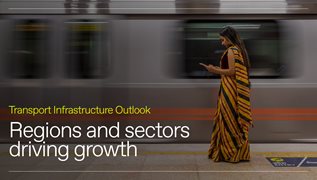Global transport infrastructure 2025: Drivers, challenges and regional realities
Economic development prompts massive project pipeline
By AnsaradaWed May 21 2025Industry news and trends, Innovation, Tenders

There are very different levels of economic growth, technological innovation and sustainability commitments among nations undertaking massive transport infrastructure initiatives.
Some countries are still building modern transport systems, while others are employing the best of digital tech to retrofit existing systems for today’s commuters.
Drawing on insights from our 2025 Transport Infrastructure Outlook Report, developed in partnership with Infralogic, this blog explores the forces boosting and hindering transport infrastructure development worldwide.
Project drivers: contrasting forces propel development
Let’s unpack the three major tailwinds behind global transport infrastructure developments.
1. Economic growth catalyzes mega projects
According to the 2025 Transport Infrastructure Outlook Report, based on the insights of 150 senior global executives, 52% of respondents say economic development is the top driver of transport infrastructure projects. This figure soars to 68% in Asia-Pacific, where rapid urbanization and population growth are transforming economies.
By 2050, the Asia Pacific region’s urban population is projected to grow by 1.2 billion, up 50% from current levels. So countries like India, Indonesia and Vietnam are trying to build massive infrastructure initiatives to support industrialization, trade and job creation. India’s Sagarmala port modernization and Indonesia’s Trans-Java Toll Road are examples of this growth-first approach.
In contrast, while economic development remains significant in the Americas and Europe and the Middle East (EMEA), countries in these regions are more focused on modernizing aging assets. For example, the US is upgrading ports and highways, while Europe is investing in rail electrification under the TEN-T network.
2. Technological advances demonstrate a global divide
Although bulky, immoveable transport infrastructure may not appear synonymous with digital tech, innovation is a key driver in new projects across the Americas and EMEA.
For instance, in the US, smart highways and electronic port systems such as semi-automated cranes and AI-driven logistics platforms are renewing aging assets.
Similarly, across Europe, the Digital Automatic Coupler (DAC) initiative aims to automate rail freight, aligning with the EU Green Deal’s decarbonization goals. Investments in smart grids and electric vehicle (EV) charging networks underscore the commitment to sustainable transport in Europe.
3. Differing regional priorities around sustainability
With quality of life paramount across the region, it’s no wonder 40% of EMEA respondents prioritize social benefits such as public transit accessibility and urban mobility projects such as expanded metro networks in Paris and Berlin.
However, an emphasis on sustainability is not universal. Only 25% of respondents globally cite environmental sustainability as a standalone driver. For instance, electrified transit in Europe and green port upgrades in Asia show sustainability considerations are being made in major transport infrastructure projects.
Project challenges: funding, ESG and the supply chain squeeze
Countries are working their way around three major roadblocks that stand in the way of transport infrastructure projects being started and completed.
1. Cost and access to capital
Demographics shape infrastructure needs unevenly across regions. This is especially apparent in Asia Pacific, where rapid population growth in countries like India, Indonesia and Vietnam necessitate expanded transport networks.
In contrast, 20% of the challenge in EMEA and 18% in the Americas reflects aging populations in developed markets, which prioritize infrastructure adaptations for older demographics.
Notably, Africa’s population growth, although part of the EMEA region, receives limited attention due to funding gaps, highlighting diverging priorities within the same geographic bloc.
2. ESG is a divisive topic
Different areas take different approaches to ESG. In the EU, strict frameworks like the Corporate Sustainability Reporting Directive (CSRD) require infrastructure developers to integrate ESG criteria into projects.
In the Americas, infrastructure decision-making reflects polarized ESG adoption. While some US states implement green mandates, others dismiss them as regulatory overreach. Latin America shows gradual ESG momentum, though it remains secondary to urgent developmental challenges like poverty reduction and basic service provision.
Asia-Pacific’s approach is marked by pragmatism, where sustainability goals are often overshadowed by the urgency of large-scale projects.
Experts acknowledge ESG notions are impacting infrastructure projects in different ways.
“ESG is definitely a factor, but the debate is around how much weight it should carry. Should it decide whether a new toll road gets built? Probably not. But should it be part of evaluating the best option? Absolutely,” says infrastructure expert, Craig Covil, Principal and Managing Director, C2 Consulting.
3. Supply chains and skills gaps stymie projects
Twin handbrakes in global infrastructure are affecting all markets. The research in the report shows supply chain disruptions account for 22% of global infrastructure challenges. In particular, post-pandemic bottlenecks continue to strain semiconductor-dependent industries such as electric vehicle manufacturing and smart infrastructure development.
Concurrently, skills shortages represent 20% of global infrastructure constraints, driven by divergent regional dynamics. In Europe and North America, aging workforces struggle to meet the technical requirements of green energy and digital transformation projects.
Meanwhile, the Asia Pacific region faces a contrasting hurdle: rapidly training millions of new workers to keep pace with unprecedented construction growth.
Bridging ambition and reality across regional projects
Global regions are approaching transport infrastructure development in different ways.
1. Asia-Pacific: growth at all costs?
The area’s infrastructure boom is unparalleled yet risky. India’s debt-driven strategy, exemplified by its National Infrastructure Pipeline (NIP), prioritizes rapid expansion through heavy reliance on public borrowing, sparking debates about long-term fiscal stability.
At the same time, Vietnam’s Public-Private Partnership (P3) reforms, although designed to attract foreign capital for ports and energy projects, continue to face implementation delays due to bureaucratic inefficiencies.
2. EMEA balances sustainability and speed
Europe’s green transition faces tension between ambition and execution. Regulatory complexity, including overlapping EU and national sustainability standards, has slowed approvals for critical projects.
While the EU’s €724 billion Recovery and Resilience Facility seeks to accelerate climate-aligned infrastructure, its stringent compliance requirements create administrative bottlenecks.
Africa’s infrastructure gap persists, despite flagship projects like the LAPSSET corridor and Abidjan-Lagos Highway. These initiatives remain dependent on foreign investment, which is a challenge compounded by political volatility and currency instability.
3. Americas managing innovation amid inequality
The US is using technology to optimize infrastructure, but not without friction. For instance, while automation in ports and smart highway systems boosts efficiency introducing new tech is triggering workforce disputes over job displacement.
Latin America’s divided progress is stark: Chile and Brazil advance renewable energy grids and green hydrogen hubs, while nations like Bolivia and Honduras grapple with outdated road networks and inadequate access to basic utilities.
Looking ahead, bridging regional disparities and advancing climate goals to address global transport infrastructure challenges will require collaboration, innovative financing models and technology-driven strategies.


